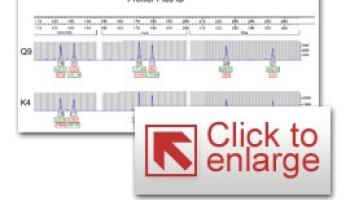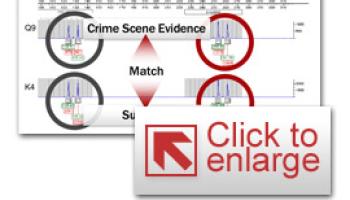Aviso de archivo
Esta es una página de archivo que ya no se actualiza. Puede contener información desactualizada y es posible que los enlaces ya no funcionen como se pretendía originalmente.
Home | Glossary | Resources | Help | Contact Us | Course Map
When the DNA profile in a known reference sample is the same as that found in a crime scene sample, the profiles are said to match, meaning that the donor of the known reference sample is a potential contributor of the DNA in the crime scene sample. When the DNA profiles are different, the known donor is excluded as a contributor to the evidence sample. When comparing DNA profiles, the results at all tested loci are considered.
DNA profiling is carried out typically at 13 specific genetic loci. A 14th loci, (amelogenin) is also tested and identifies the gender of the sample contributor. Profiling attempts can yield a complete profile, a partial profile, or no profile, depending on sample quantity and the extent of sample degradation. Moreover, every laboratory will have an established analytical threshold for accepting a result at a locus as conclusive. DNA profile data that fall beneath the threshold at any locus dictate that the result will be inconclusive and, while used for profile comparison(s), these data cannot be used when calculating the statistical weight that will be assigned in the case of a profile match.
When the statistical weight of a profile match is calculated, only those loci that demonstrated conclusive profiling results will be incorporated into the calculation. That calculation will be carried out, regardless of how few loci yielded conclusive results. Again, it is important to remember that the resulting alleles developed at all loci are used in the profile comparison, even if some are ultimately not used for statistical calculations.
Additional Online Courses
- What Every First Responding Officer Should Know About DNA Evidence
- Collecting DNA Evidence at Property Crime Scenes
- DNA – A Prosecutor’s Practice Notebook
- Crime Scene and DNA Basics
- Laboratory Safety Programs
- DNA Amplification
- Population Genetics and Statistics
- Non-STR DNA Markers: SNPs, Y-STRs, LCN and mtDNA
- Firearms Examiner Training
- Forensic DNA Education for Law Enforcement Decisionmakers
- What Every Investigator and Evidence Technician Should Know About DNA Evidence
- Principles of Forensic DNA for Officers of the Court
- Law 101: Legal Guide for the Forensic Expert
- Laboratory Orientation and Testing of Body Fluids and Tissues
- DNA Extraction and Quantitation
- STR Data Analysis and Interpretation
- Communication Skills, Report Writing, and Courtroom Testimony
- Español for Law Enforcement
- Amplified DNA Product Separation for Forensic Analysts



